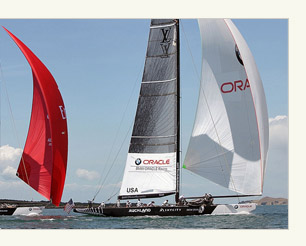|
|
NAUTICAL
ENGINEERING
 |
Wet and Wild
Open
seas never stop luring adventurers and
competitors. Just ask Abby Sunderland, 16, whose
attempt to sail solo around the world was cut
short by gale-force winds. Or the U.S. America's
Cup team, which borrowed from aeronautical
engineering to design a faster racing yacht.
Challenges abound below the surface too, as the
participants in our feature story on the Sea Perch
program discovered.
Learn
More
|
|
|
High
school math students learn how the shape of sails
affects the movement of sailboats before applying
the Pythagorean Theorem to their own sail
design. Plunging into underwater experiments,
students in grades 5-8 run tests of submarine buoyancy and
submersion, while those in grades 7-12 explore
the use of ballasts on
submarines.
Learn
More |
|
A
simulated shipwreck tested the talents of students
from four Boston-area schools, who built remotely
operated underwater vehicles to check for leaks of
hazardous cargo and salvage the wreck.
Learn
More |
Middle
school students in McLean, Va., took up a
challenge to take a snapshot of the Earth's
curvature without spending more than $200. They
pulled it off, using a cooler, camera, weather
balloon, GPS cellphone -- and all their math
ability.
Learn
More |
Struggling
swimmers gain help this summer from EMILY, a
robotic buoy equipped with a sonar
device and an electric high-speed
propeller that can speed it to drowning
victims six times faster than a human lifeguard.
Read about this engineering marvel on the eGFI students
blog.
Discussion
questions: What are the advantages of a robotic
lifeguard? How are humans
better?
Learn
More |
|
|
|
 |
Advertising
|
|
|
|
|
|